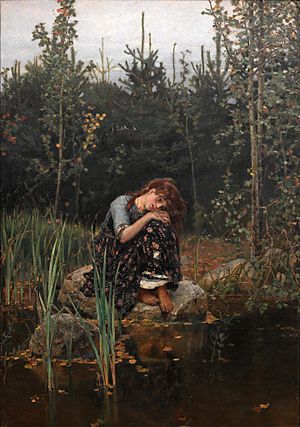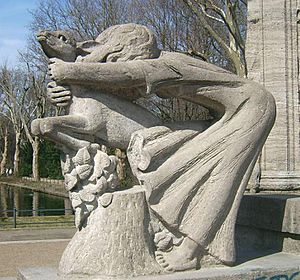Brother and Sister facts for kids
Quick facts for kids Brother and Sister |
|
|---|---|

Sister Alenushka Weeping about Brother Ivanushka by Viktor Vasnetsov, 1881.
|
|
| Folk tale | |
| Name | Brother and Sister |
| Also known as | Little Sister and Little Brother |
| Data | |
| Aarne–Thompson grouping | ATU 450 |
| Country | Germany |
| Published in | Grimm's Fairy Tales |
"Brother and Sister" (also called "Little Sister and Little Brother") is a classic European fairy tale. It was written down by the famous Brothers Grimm as part of their collection (KHM 11). This story is a Type 450 tale in the Aarne–Thompson–Uther Index. In Russia, a similar story is known as Sister Alionushka, Brother Ivanushka. This version was collected by Alexander Afanasyev in his book Narodnye russkie skazki.
Contents
Where the Story Comes From
The first known version of "Brother and Sister" appeared around the 1600s. It was in a book called Pentamerone by Giambattista Basile. This early tale was named "Ninnillo and Nennella." Since then, the story has traveled across Europe. It has many different titles but usually keeps its main plot.
The Brothers Grimm published a shorter version of this tale in 1812. This was in the first edition of their book, Kinder- und Hausmärchen. They later made it much longer and changed it in 1819. Their story came from a German storyteller named Marie Hassenpflug.
Sometimes, "Brother and Sister" gets mixed up with another Grimm fairy tale, "Hansel and Gretel". "Hansel and Gretel" was also sometimes called "Little Brother and Little Sister." The Grimms chose "Hansel and Gretel" for that story. They kept the title "Brother and Sister" for this specific tale. But some books still use the confusing title for "Hansel and Gretel."
What Happens in the Story?
The story begins with a brother and sister who are very unhappy. Their wicked stepmother is also a witch and treats them badly. So, they decide to run away from home. They wander into the countryside and spend the night sleeping in the woods.
The next morning, the boy feels very thirsty. The children start looking for a clear spring of water. But their stepmother has found out they escaped. She used her magic to put a spell on all the springs in the forest. As the boy is about to drink from the first spring, his sister hears something. The rushing water seems to say, "Whoever drinks from me will become a tiger."
The girl desperately begs her brother not to drink. She fears he will turn into a tiger and attack her. So, they continue their journey. When they reach the second spring, the girl hears it say, "Whoever drinks from me will become a wolf." Again, she tries hard to stop her brother from drinking. He agrees, but only if he can drink from the next spring they find.
They arrive at the third spring. The girl hears the water cry, "Whoever drinks from me will become a deer." But it is too late. Her brother has already taken a drink. Right away, he changes into a deer.

After their sadness fades, the children decide to live in the woods forever. The girl takes good care of her deer brother. She ties her gold chain around his neck. They find a small house deep in the woods. They live there happily for several years.
One day, a hunting party disturbs their peaceful life. The king himself is part of the hunt. He follows the strange deer back to their little house. When he sees the beautiful girl, he immediately asks her to marry him. She agrees, and she becomes queen. They all live happily in the king's castle. Time passes, and the queen gives birth to a son.
However, their wicked stepmother soon learns they are still alive. She plans to harm them. One night, she takes the queen's place. She uses magic to make her own disfigured daughter look like the queen. The real queen's ghost secretly visits her baby's bedside. This happens for three nights in a row. The king notices this strange event. He then discovers his stepmother's evil plan.
The queen comes back to life when the king embraces her. Her stepfamily is then brought to justice for their terrible actions. The stepdaughter is sent away into the woods. There, she faces a harsh fate. The stepmother is punished severely. At the exact moment of her death, the deer turns back into a human. Finally, the brother and sister are reunited. They live happily ever after.
Other Versions of the Tale
"Brother and Sister" is similar to other AT-450 tales. One example is "The Lambkin and the Little Fish".
In some versions of the story, the queen is not killed. Instead, the wicked stepmother puts her into a deep sleep. The king then wakes her up.
How the Story Lives On
Television Shows
Nippon Animation Company from Japan made this story into an episode. It was part of season two of their anime TV series, Grimm's Fairy Tale Classics. In this version, the siblings have different names. The brother is Rudolph, and the sister is Rosa. Rosa is not killed by the Witch. Instead, she is taken into a mountain. She uses a special power to send her soul out. This lets her feed her baby, but it makes her very weak. Her husband, the King, and his soldiers rescue her just in time. The evil stepsister is not in this version. The Witch dies offscreen, meaning her death is not shown.
A Hungarian version of the tale was made into an episode. This was for the Hungarian TV series Magyar népmesék ("Hungarian Folk Tales"). Its title was Cerceruska. In this story, the maiden has a little sister. This sister drinks from the water in the woods. She then turns into a deer.
Books and Poems
Many modern writers have used this fairy tale in their works. "In the Night Country" is a story by Ellen Steiber. "Brother and Sister" is a poem by Terri Windling. "Sister and Brother" is a poem by Barth Anderson. These works explore the themes of the original fairy tale.
See also
 In Spanish: Hermano y hermana (cuento alemán) para niños
In Spanish: Hermano y hermana (cuento alemán) para niños

